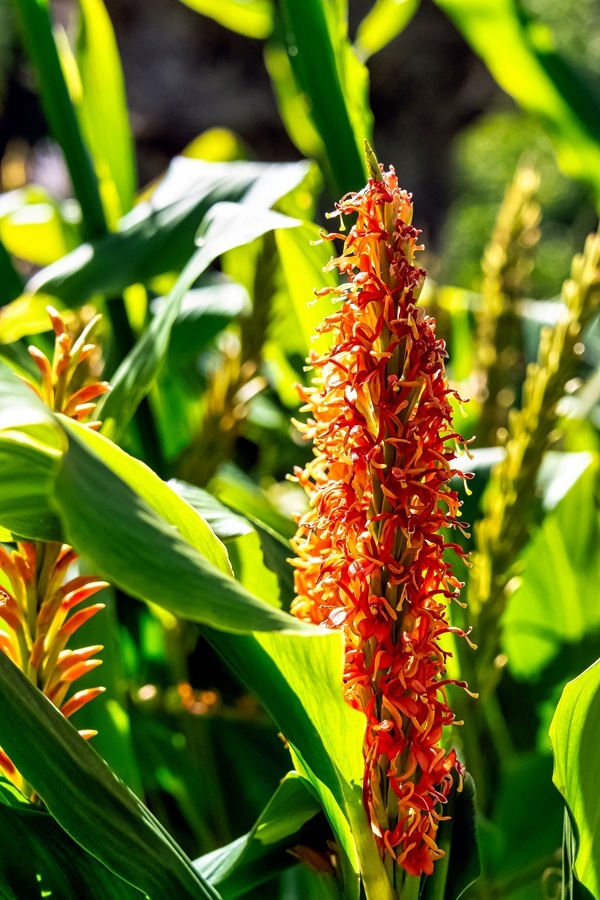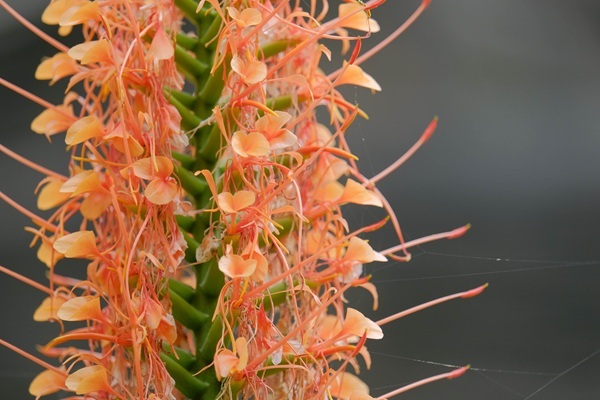

Blooms and Foliage: Hedychium (Ginger Lily) foliage is one of its standout features—lush, tropical, and architectural. The Hedychium aurantiacum folige is a lovely deep, glossy green with each lance-shaped leaf about 12+" long. It is not a dense as the traditional "white Ginger Lily;" however, the lance-shaped leaves are long and full. The plant will grow between 3-6 feet tall and several feet wide when at full maturity. This alone adds a great architectural aspect to your garden. Sometimes you'll need to trim it up or tie it up to keep it from spilling into unwanted places. If you love creating your own centerpieces, you will enjoy adding cuttings of the foliage to your arrangements. The salmon-orange flower spikes can be 6-12 inches long and sometimes even longer on well-established happy plants. The flowers usually open sequentially from bottom to top on the spike. The orange blooms are airy and bright which are perfect for those hot summer days.

Mulitplying: The Hedychium multiplies nicely. It is not aggressive. It forms nice clumps over time, and it won't take long to see yours multiply. It should double in size about every 3 years if planted correctly, and you can divide them at that time which will manage their spread, give them space to expand, and rejuvenate growth. Spring is the best time to divide them before new growth begins. Make sure that each portion will have at least one pointed bud.

Animals: Pollinators love Hedychium. We aren't always sure if it is because it is solely based on the fragrance or also because the ginger lily is one of the few flowers blooming in late summer and early fall when so many flowers can't withstand the summer heat and have long faded. Bees and butterflies are attracted to the Hedychium aurantiacum for its brightly colored flowers. Most Hedychium are moderately deer resistant due to their aromatic rhizomes and coarse foliage, but young shoots may be nibbled at in early spring if food is scarce, and deer have been known to eat plastic flowers. Generally, Hedychium is resistant to squirrels and rabbits.
Differences: We decided to put all of the information at the bottom of the page so that you could see at one glance some of the differences, especially blooming times, between the different Hedychium varieties.
| Species | Flower Color | Height | Zone 8 Bloom Time | USDA Zones | Traits & Uses |
|---|---|---|---|---|---|
| H. aurantiacum | Orange to salmon | 3–6 ft | July–August | 8–11 | Bright color, compact; great for tropical effect in mixed beds |
| H. coronarium (White Ginger Lily) | White, fragrant | 4–6 ft | Aug–Oct | 7b–11 | Highly fragrant; very cold-tolerant; excellent for moist areas |
| H. densiflorum | Orange | 3–5 ft | June–July | 7–10 | Earliest bloomer; great for cooler climates; dense flower spikes |
| H. ellipticum | White w/ red-orange spots | 3–6 ft | July–August | 8–11 | Speckled flowers, ornamental foliage; compact grower |
| H. flavum | Lemon yellow | 4–7 ft | July–August | 8–11 | Soft color, elegant form; less common in trade |
| H. greenii | Red bracts, orange-red flowers | 3–4 ft | July–August | 8–11 | Grown as much for red stems and foliage as for flowers |
| H. thyrsiforme | Cream to pale yellow | 4–6 ft | Aug–Sept | 9–11 | Late bloomer, upright growth; more tropical in habit |
| H. gardnerianum (Kahili Ginger) | Yellow w/ red stamens | 5–8 ft | Aug–Sept | 8–11 | Fragrant and bold; invasive in some areas (e.g., Hawaii) |
| H. griffithianum | White to soft pink | 3–5 ft | July–August | 8–11 | Graceful, less vigorous; refined appearance |
| H. speciosum | Yellow-orange w/ red marks | 4–6 ft | Aug–Sept | 8–11 | Bold color, striking flowers; good for back borders |
Blooms and Foliage: Hedychium (Ginger Lily) foliage is one of its standout features—lush, tropical, and architectural. The Hedychium aurantiacum folige is a lovely deep, glossy green with each lance-shaped leaf about 12+" long. It is not a dense as the traditional "white Ginger Lily;" however, the lance-shaped leaves are long and full. The plant will grow between 3-6 feet tall and several feet wide when at full maturity. This alone adds a great architectural aspect to your garden. Sometimes you'll need to trim it up or tie it up to keep it from spilling into unwanted places. If you love creating your own centerpieces, you will enjoy adding cuttings of the foliage to your arrangements. The salmon-orange flower spikes can be 6-12 inches long and sometimes even longer on well-established happy plants. The flowers usually open sequentially from bottom to top on the spike. The orange blooms are airy and bright which are perfect for those hot summer days.

Mulitplying: The Hedychium multiplies nicely. It is not aggressive. It forms nice clumps over time, and it won't take long to see yours multiply. It should double in size about every 3 years if planted correctly, and you can divide them at that time which will manage their spread, give them space to expand, and rejuvenate growth. Spring is the best time to divide them before new growth begins. Make sure that each portion will have at least one pointed bud.

Animals: Pollinators love Hedychium. We aren't always sure if it is because it is solely based on the fragrance or also because the ginger lily is one of the few flowers blooming in late summer and early fall when so many flowers can't withstand the summer heat and have long faded. Bees and butterflies are attracted to the Hedychium aurantiacum for its brightly colored flowers. Most Hedychium are moderately deer resistant due to their aromatic rhizomes and coarse foliage, but young shoots may be nibbled at in early spring if food is scarce, and deer have been known to eat plastic flowers. Generally, Hedychium is resistant to squirrels and rabbits.
Differences: We decided to put all of the information at the bottom of the page so that you could see at one glance some of the differences, especially blooming times, between the different Hedychium varieties.
| Species | Flower Color | Height | Zone 8 Bloom Time | USDA Zones | Traits & Uses |
|---|---|---|---|---|---|
| H. aurantiacum | Orange to salmon | 3–6 ft | July–August | 8–11 | Bright color, compact; great for tropical effect in mixed beds |
| H. coronarium (White Ginger Lily) | White, fragrant | 4–6 ft | Aug–Oct | 7b–11 | Highly fragrant; very cold-tolerant; excellent for moist areas |
| H. densiflorum | Orange | 3–5 ft | June–July | 7–10 | Earliest bloomer; great for cooler climates; dense flower spikes |
| H. ellipticum | White w/ red-orange spots | 3–6 ft | July–August | 8–11 | Speckled flowers, ornamental foliage; compact grower |
| H. flavum | Lemon yellow | 4–7 ft | July–August | 8–11 | Soft color, elegant form; less common in trade |
| H. greenii | Red bracts, orange-red flowers | 3–4 ft | July–August | 8–11 | Grown as much for red stems and foliage as for flowers |
| H. thyrsiforme | Cream to pale yellow | 4–6 ft | Aug–Sept | 9–11 | Late bloomer, upright growth; more tropical in habit |
| H. gardnerianum (Kahili Ginger) | Yellow w/ red stamens | 5–8 ft | Aug–Sept | 8–11 | Fragrant and bold; invasive in some areas (e.g., Hawaii) |
| H. griffithianum | White to soft pink | 3–5 ft | July–August | 8–11 | Graceful, less vigorous; refined appearance |
| H. speciosum | Yellow-orange w/ red marks | 4–6 ft | Aug–Sept | 8–11 | Bold color, striking flowers; good for back borders |